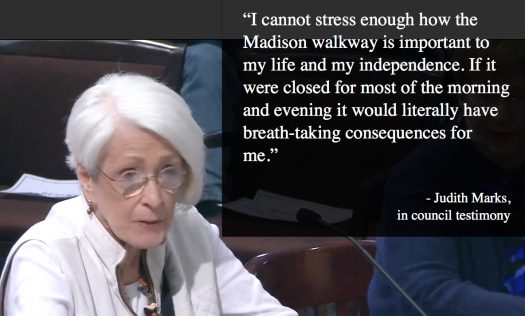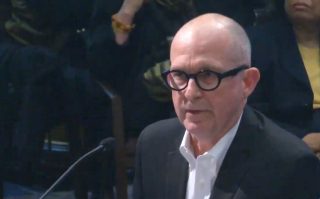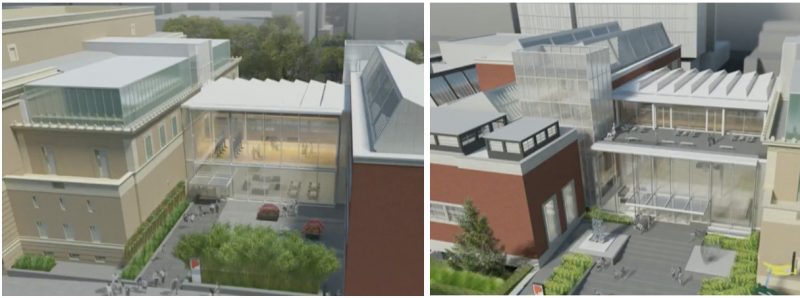 The Portland Art Museum says their $50 million expansion plans would create one of our city’s best public spaces — but it’s the existing public space they want to close that has put their project on shaky ground.
The Portland Art Museum says their $50 million expansion plans would create one of our city’s best public spaces — but it’s the existing public space they want to close that has put their project on shaky ground.
Portland City Council held its first hearing on PAM’s Rothko Pavilion project last week. At issue is whether or not the City should amend an existing public easement on SW Madison between Park and 10th that runs between the museum’s two main buildings. PAM’s new pavilion aims to connect the buildings with a new structure that would display art, host events, and serve as its main entrance. The public would be allowed to move through the new structure without buying a ticket; but access would be limited to museum hours (10:00 am to 5:00 pm Sunday through Wednesday and 10:00 to 8:00 pm Thursday and Friday) and people riding bicycles or walking dogs would be completely prohibited.
“When the museum brought this to me, I made it clear to them it would spark some controversy and concern and that it does fly in the face of some pretty specific Central City [Plan] policies around connectivity and accessibility.”
— Dan Saltzman, Portland City Commissioner
On Thursday of last week, museum representatives tried to make the case to Mayor Ted Wheeler and the rest of council that the benefits of museum expansion outweigh the loss of street connectivity and safety of people walking and biking in the area. After their invited testimony, 25 members of the public voiced their opinions. The vast majority (all but three or four) expressed passionate opposition and encouraged Council to require the museum to come up with a different design that would achieve their expansion goals and still maintain unfettered and unobstructed access.
This opposition came just a few days after we reported that the City of Portland’s Bicycle Advisory Committee and the Pedestrian Advisory Committee also oppose any change to the existing easement. At Council Thursday we learned that Oregon Walks and the Portland Commission on Disabilities are also in opposition.
Those warning flags were seen by Transportation Commissioner Dan Saltzman. In his introduction of the ordinance, Saltzman said he warned PAM their idea would not be popular. “I made it clear to them it would spark some controversy and concern and that it does fly in the face of some pretty specific Central City [Plan] policies around connectivity and accessibility,” he said. “They understood, and made a compelling case for a concept that strengthens central city policies around cultural institutions and innovation.”
Given a chance to make that case to the public, PAM Director Brian Ferriso said the new structure would help the museum offer better access and programming for its customers and that the new building itself would, “Serve as a visual invitation for the public.” Ferriso said maintaining an open walkway “is not possible.” “The entire space must be enclosed and temperature-regulated to protect the art,” he explained. “We believe this benefits the community in a deep and meaningful way.”

The museum’s Chief Advancement Officer JS May shared images of the proposed pavilion and said, “As you can see, leaving an 8-10 foot wide open-air easement between the buildings would result in a pavilion that doesn’t solve the problem of connectivity between our two buildings that it’s design to address. And designing gates or some other type of barrier would create security issues that would distract from the goal to create one of Portland’s grand public spaces.”
But the people who showed up to testify weren’t having it. And neither was Commissioner Amanda Fritz.
After Commissioner Nick Fish asked May if the proposal had any issues with the City’s Comprehensive Plan and May replied, “I don’t think so,” Fritz interjected: “There is testimony in the record from the West Quadrant Plan. Would you care to address those?”
“I don’t know the details deeply,” May replied, “So I’m not the person to address that.”
This was a curious exchange because Commissioner Saltzman said a few minutes earlier that he had already “warned” the museum that their proposal, “does fly in the face of some pretty specific Central City [Plan] policies.”
Fritz continued her questioning of May.
“The Planning and Sustainability Commission has asked about this. The pedestrian and bicycle advisory committees, Oregon Walks, and the Commission on Disabilities are all in opposition to this. Would you care to address those concerns?” she asked.
“There are definitely people who will be inconvenienced by the pavilion in the hours it is closed, we can’t deny that,” May replied. “The fundamental question is: Is the greater good of the city served by the pavilion being a destination for people and a public space, or is that not the case?”
To which Fritz replied, “But there is a public space there now which is really lovely.”
Fritz continued her skeptical line of questioning by saying her concerns are particularly about the safety of bicycle users who rely on the existing walkway (which is legal to bike on, because it’s not technically considered a sidewalk) as an alternate to SW Jefferson.
Advertisement

Once public testimony began, Council heard nearly two dozen people — most of them nearby residents and museum members/donors — object to the proposal. People not only want the plaza to remain unobstructed, they also accuse the museum of not listening to their concerns. The plans and approach taken by the museum thus far were called “elitist” and “arrogant”.
PAM member and supporter Wendy Rahm said the plaza is a “critical part of a larger pedestrian system” and that the museum’s expansion would “create a superblock and a physical and psychological barrier.” “There’s a ring of elitism to it,” she added.
Another PAM member, Katie Urey, said she was “very disappointed” that PAM needs to be lectured about the importance of connectivity and public access. “I’m embarrassed by the arguments of PAM,” she said, “I find them inward-looking and arrogant.”
A man who lives in the condominiums adjacent to the museum and who called himself a patron-level supporter of the museum said he and other neighbors met with PAM staff and architects over one year ago. “There must be a design solution that would allow an eight-foot wide passageway to stay open,” he said. Then he added, “I and others have requested they develop an alternative design, but our requests have never been taken seriously. I think the museum has felt they could just push their way through the planning process.” (It was pointed out that PAM has stated on their website that groundbreaking for the project would happen in 2018.)
“The connection matters in the network, it serves a function in the network, and it enhances the experience and delight of walking in our city… The importance of connectivity in the network cannot be overstated.”
— Ellen Vanderslice
One person invoked urban planning legend Jane Jacobs and said the museum’s pavilion would make the area less vibrant and less safe because it would encourage fewer “eyes on the street.” The name of Donald Trump also came up as one man described the proposal as a “wall to keep people out”.
Portland-based civil rights lawyer Lake Perriguey said the plans are akin to, “A wall and a travel ban in one.”
Ruth Ann Barrett, who runs the @PDXDowntowner Twitter feed and blog, said the proposal from PAM “has a landed-gentry feel to it” and that it’s “not drawing from the residents who live there.” She also poked at the museum’s name from the space. “To call it ‘The Commons’ is a bit of an exaggeration.”
At one point Commissioner Fish stepped in to encourage people to keep their testimony more respectful and to be nicer to museum staff. He never said which way he’d vote, but throughout the hearing Fish seemed very supportive of the museum. After Bicycle Advisory Committee member Elliot Akwai-Scott shared opposition to the plans, Fish asked him “Who is using this right-of-way for bicycle transportation?” “I’ve spent a lot of time in the area and have never seen a bike traverse this. It’s not what I would use,” Fish said.
Akwai-Scott informed Fish that he used the plaza a lot as a student at nearby Lincoln High School and then Portland State University. “I’d turn your question around and say, imagine how much more highly used this walkway would be if we didn’t have I-405 blocking the way. Every block is precious.”
The concern about precedent also came up several times. One nearby resident said his condominium wanted to close the public walkway on the adjacent block, but one of the reasons they fought (and won) to keep it open was because of the presence of the museum’s walkway. In other words, if the museum walkway closes, it would only be a matter of time before other property owners follow suit.
Another local resident, Mary Vogel, a self-described, “cyclist in that ‘female over-50’ category that planners are hard-pressed to attract to cycling,” said the Madison plaza route is her “safest and easiest path to the Hawthorne Bridge.” Vogel added that, “In an era of climate change and dwindling funds to repair the damage cars do to roads, we are a public benefit too!”
Perhaps the most persuasive testimony against the plan came from a retired PBOT staffer and widely recognized walking advocate Ellen Vanderslice. Vanderslice was the staffer who put together the city’s first Pedestrian Master Plan. “I’m here to oppose building a structure on Madison Plaza,” she said. “The connection matters in the network, it serves a function in the network, and it enhances the experience and delight of walking in our city… The importance of connectivity in the network cannot be overstated.”
After hearing about two hours sharp critiques, Commissioner Saltzman decided to refer the ordinance back to his office. “This will be continued,” he said. Saltzman’s Chief of Staff Matt Grumm said the issue might be back for consideration by council, “In about a month.” A briefing on the subject at the Planning and Sustainability Commission that was initially planned for today has also been postponed.
— Jonathan Maus: (503) 706-8804, @jonathan_maus on Twitter and jonathan@bikeportland.org
BikePortland is supported by the community (that means you!). Please become a subscriber or make a donation today.

